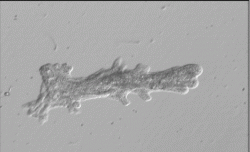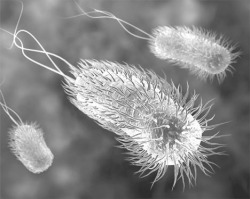Ameba (previously Amoeba)

This is the genus that most people consider when the word "amoeba" is mentioned. Amoeba proteus is a so called "giant amoeba", being large compared to the huge number of other genera generally considered to belonging to the amoeba. Recent molecular data (Bolivar et al, 2001) (SSUrRNA) suggest that Amoeba is most closely related to Chaos and less so to genera such as Rhizamoeba, Paraflabellula, Leptomyxa, Hartmanella and Echinamoeba. The nuclear membrane of Amoeba sp has a honey comb appearance (Goldstein et al, 1978) presumably as it is studded with so many nuclear pore complexes. The nucleus of Amoeba proteus and A. discoides probably contains histone-like proteins (Sopina et al, 1979) as cross reactive proteins have been detected by immuno-fluorescence using antibodies directed against calf thymus histones. So far the relationship to other genera of amoeba is a bit of a mystery as little genetic information is known. The determination of the SSUrDNA gene of Amoeba will be complicated by the fact that this group has to be cultured with other protists whose presence may make the unambiguous isolation of the gene difficult. Saccamoeba another member of the Family Amoebidae have been analysed at the SSUrDNA level, and if the family turns out to be valid then we can assume the Amoeba fits into the general relationship in a similar position (Amaral Zettler et al, 2000). A myosin heavy chain gene from Amoeba proteus has been cloned and sequenced (Oh & Jeon, 1998) so this may be used when other sequences become known for other amoeba genera, so far there are only a handful of amoeba (Acanthamoeba, Dictyostelium & Entamoeba ) that have conventional myosin genes sequenced.
Protista or Protoctista , in the five-kingdom system of classification, a kingdom comprising a variety of unicellular and some simple multinuclear and multicellular eukaryotic organisms. Protists, which are eukaryotes , have cells that have a membrane-bound nucleus, DNA that is associated with histone proteins, and organelles (e.g., mitochondria and chloroplasts). A recently proposed system of classification designates the eukaryotes as one of three great groups of life (beside bacteria and archaea) and places the protists within it.
It has been hypothesized that the organelles in protists descend evolutionarily from specialized symbiotic bacteria living within the cells of other bacteria, contributing at least in part to the transition from prokaryotic (bacterial) cells (the earliest form of life on the planet, dating back at least 3.5 billion years) to early eukaryotic cells (the cells that define protists, dating back 1.5 billion years) and the more complex life forms of later plants and animals.
The protists comprise a very diverse group of organisms. They include some algae , the protozoans , and multicellular or multinucleate autotrophs, such as the water molds . Many have flagella that enable them to move about. Before the advent of modern biochemistry and the electron microscope, these organisms were fit into the plant and animal kingdoms. It is now thought that, although green plants probably evolved from the green algae and animals from some other early forms, most modern protists have followed independent evolutionary lines. There are approximately 60,000 living species of protists.
"Protista." The Columbia Encyclopedia, Sixth Edition. 2008. Encyclopedia.com. 13 Feb. 2009 <http://www.encyclopedia.com>.
General Ameba Info

The ameba is one of the simplest of the protozoa. It can be found in ponds and rivers and on the surface of the leaves of water plants. It looks like a grayish blob under a microscope. Its shape is constantly changing as it moves along.
One characteristic of the ameba is its false feet, that scientists call pseudopodia. The false feet extend out and then the rest of the body follows the false feet along. The ameba eats little animals and plants. It sends out its false feet to surround the plant or animal and then pops it right into the cell!
The ameba has tiny sacs in its body called vacuoles. Some of the vacuoles have food in them. Others collect water and squeeze the extra water out.
Oxygen enters the ameba through its thin covering called a cell membrane. The carbon dioxide leaves the ameba through the cell membrane as well.
The ameba avoids light but swims faster in warmer temperatures. The ameba reproduces by splitting in half. This is called fission. The ameba's nucleus or center splits in half and goes to opposite ends of the cell. Then the cell narrows and splits in half.

